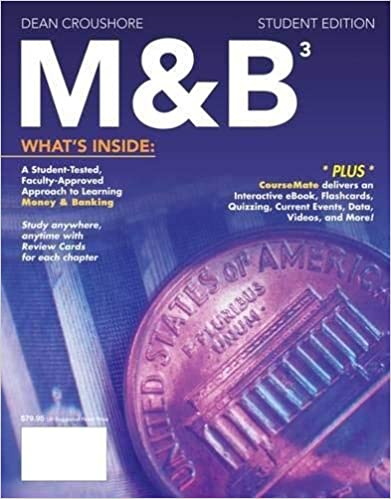
M&B3 3rd Edition by Dean Croushore
Edition 3ISBN: 978-1285167961
M&B3 3rd Edition by Dean Croushore
Edition 3ISBN: 978-1285167961 Exercise 1
Describe the major types of risks to fi nancial securities, and give a specifi c example of each. How do investors measure risk
Explanation
The types of Risks can be divided into two forms:
• Systematic Risks or General risks or Market Risks
• Unsystematic Risks or Specific Risks or Issuer Risks
The major types of Risks to Financial Securities are:
• Default Risk: When the investor of debt securities realizes that the issuer of security may not be able to pay the interest or repay, the principal when due such a risk is termed as Default Risk.
• When Equity Securities investors face the risk of unpaid dividend payout; for instance, Iterana Industries Ltd., paid dividends per share of $1.50 in 1998, $1.70 in 1999, $1.90 in 2000, $2.10 in 2001 and $2.30 in 2002, with a current yield averaging 3.0 percent. Because of some technical problems and unexpected risks inherited to working of company and bankruptcy it paid $1.78 in2003. Investors in equity securities can never estimate the amounts of dividend going to be received.
• Change in the price of the securities: the market price of securities goes both sides upwards risk - when the price rise of the securities, and downwards risk - when the price declines of securities.
Even though a number of different securities prices rise and fall together, still every security has its own individual risk. For instance, price of Iterana Industries fell from $40.44 per share at the start of 1996 to $3.59 per share at the start of 1997.
• Change in Inflation rate: the change in inflation rate diversifies the change
in the average price of goods and services. For instance, a person name Jack knows that his security will pay him $2000 in one year, but he does not know how much he will be able to buy with that amount of money. If inflation is low, he will be able to buy more, but if inflation is high, he will not be able to buy as much.
Generally, the most widely used measure of risk by all investors is the standard deviation. This helps in determination of various possible returns from the expected return.
Steps to measure it are:
1. Calculate the difference of each return from the expected return.
2. Square each of those differences.
3. Multiply those squared differences with the probability that the return occurs.
4. Add all the numbers from step3 for all the possible returns.
5. Take the square root of the sum in Step 4.
Such square root gives the standard deviation on two different securities. Higher, for securities whose deviations are bigger i.e. whose returns differ from the expected value by greater value. This standard deviation is only risk.
• Systematic Risks or General risks or Market Risks
• Unsystematic Risks or Specific Risks or Issuer Risks
The major types of Risks to Financial Securities are:
• Default Risk: When the investor of debt securities realizes that the issuer of security may not be able to pay the interest or repay, the principal when due such a risk is termed as Default Risk.
• When Equity Securities investors face the risk of unpaid dividend payout; for instance, Iterana Industries Ltd., paid dividends per share of $1.50 in 1998, $1.70 in 1999, $1.90 in 2000, $2.10 in 2001 and $2.30 in 2002, with a current yield averaging 3.0 percent. Because of some technical problems and unexpected risks inherited to working of company and bankruptcy it paid $1.78 in2003. Investors in equity securities can never estimate the amounts of dividend going to be received.
• Change in the price of the securities: the market price of securities goes both sides upwards risk - when the price rise of the securities, and downwards risk - when the price declines of securities.
Even though a number of different securities prices rise and fall together, still every security has its own individual risk. For instance, price of Iterana Industries fell from $40.44 per share at the start of 1996 to $3.59 per share at the start of 1997.
• Change in Inflation rate: the change in inflation rate diversifies the change
in the average price of goods and services. For instance, a person name Jack knows that his security will pay him $2000 in one year, but he does not know how much he will be able to buy with that amount of money. If inflation is low, he will be able to buy more, but if inflation is high, he will not be able to buy as much.
Generally, the most widely used measure of risk by all investors is the standard deviation. This helps in determination of various possible returns from the expected return.
Steps to measure it are:
1. Calculate the difference of each return from the expected return.
2. Square each of those differences.
3. Multiply those squared differences with the probability that the return occurs.
4. Add all the numbers from step3 for all the possible returns.
5. Take the square root of the sum in Step 4.
Such square root gives the standard deviation on two different securities. Higher, for securities whose deviations are bigger i.e. whose returns differ from the expected value by greater value. This standard deviation is only risk.
M&B3 3rd Edition by Dean Croushore
Why don’t you like this exercise?
Other Minimum 8 character and maximum 255 character
Character 255


